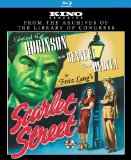| Reviews & Columns |
|
Reviews DVD TV on DVD Blu-ray 4K UHD International DVDs In Theaters Reviews by Studio Video Games Features Collector Series DVDs Easter Egg Database Interviews DVD Talk Radio Feature Articles Columns Anime Talk DVD Savant Horror DVDs The M.O.D. Squad Art House HD Talk Silent DVD
|
DVD Talk Forum |
|
|
| Resources |
|
DVD Price Search Customer Service #'s RCE Info Links |
|
Columns
|
|
|
Scarlet Street: Kino Classics Edition
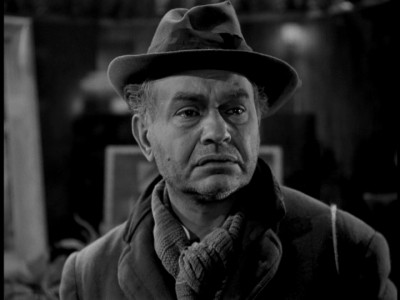
Please Note: The screen captures used here are taken from the standard-definition 2005 DVD edition, not the new Blu-ray release under review.
Although M has to be my favorite Fritz lang film, period, and I wouldn't give up Metropolis or Dr. Mabuse, the Gambler for anything, there is a part of me that's tempted to concur with the critic Dave Kehr's assertion that Lang's pre-WWII European output tended to the meretricious, and that it is his American films (Fury, The Big Heat, etc.) that represent his best, most "classic" work. That would be the part of me that's gladly, completely seduced every time I watch one of his great American noirs like The Woman in the Window or his 1945 film Scarlet Street, which is now being released to Blu-ray by Kino Classics. There is something in Lang's deservedly legendary artistic sensibility that seems most inspired when challenged to create a world in which there are either diabolical conspiracies being thrust upon mankind (as in Metropolis and, to an extent, in Dr. Mabuse) or where fate can only be seen very fatalistically as a perpetrator of cruel, fiendishly ironic jokes; and if M is the peak expression of that sensibility in Lang's earlier, German filmography, then Scarlet Street is its most potent manifestation from Lang's later, American period.
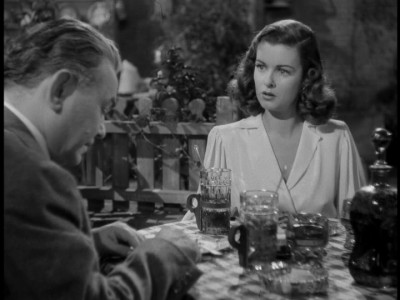
Lang re-casts his whole ensemble from the prior year's The Woman in the Window (also very well worth your while) for this picture: Edward G. Robinson returns, this time as the very unhappily married, milquetoast cashier and Sunday painter Chris Cross; Joan Bennett is back as Katherine March, or "Kitty," his shady, lady-of-the-night love interest; and Dan Duryea reprises his sneering, arrogant bad boy bit as Johnny, Kitty's lover. The film opens in a very Langian way, on a naturalistic-enough, unassuming, but effectively allegorical exterior in which we hear an organ grinder's music playing in a city street as a beautiful, well-dressed woman watches in amusement from a limousine window and takes a gleeful turn manipulating the poor creature on its leash. Lang, our organ grinder, then takes us inside to meet Chris, the main monkey of Scarlet Street, whom fate will have yanked around on his leash to the point of absolute exhaustion and defeat by the time the film ends. The mealy-mouthed, shy, middle-aged Chris is being congratulated for decades of reliable cashier at a celebratory after-work fancy-dress party, where his boss hastily gives him an expensive watch, an empty token of appreciation, before rushing out to meet his mistress, the gorgeous lady in the limo. Chris, an unprepossessing doormat, will never climb out of his rut, never have the privilege of something illicit and indulgent like the adultery so freely partaken of by his employer and social better.
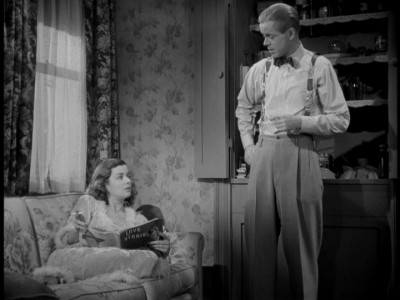
Or could he? On his way to take the subway back to Brooklyn (no fancy stuff like cars or the Manhattan skyline for this guy), he gets lost, ends up on a seedy Greenwich Village street, and, slightly drunk and keyed up, rescues a young woman (Bennett) who's being slapped around by what appears to be a thuggish assailant, whose face he doesn't get a good look at. He walks the girl home, and she's flirtatious and pretty, and so it begins. This atypically action-packed acquaintance-making leads to a series of misunderstandings and deceptions on everyone's part: Chris exaggerates his painting hobby into a brilliant career and lets Kitty think he's much more well-off than he is, and Kitty and her attacker, actually her boyfriend, Johnny, plot to use Chris's obvious crush on Kitty and bilk the old dupe for all he's worth. Which, as we can see from Chris's cramped, utterly disempowered married life with his shrewish wife, Adele (played to good comic effect by Rosalind Ivan,) and the way he lives under a looming, imposing painted portrait of her late officer-of-the-law husband, is not nearly as much as the violent, thrill-seeking, sexually uninhibited young couple imagines.
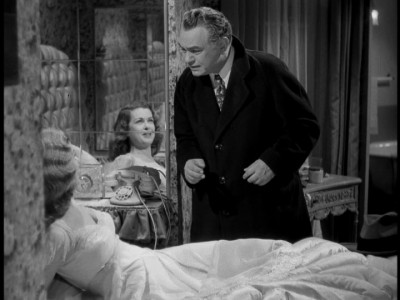
Chris flirts with Kitty, who plays along, and when he feebly confesses that he loves her but is married, she talks him into setting her up in a posh apartment, where he can also paint to his heart's content, away from the hypercritical and withering eye of the shrill Adele. Strange circumstances develop, proving that Chris need never have been such a noodle-spined pushover: Kitty and Johnny are able to get a handsome sum for his surrealist-leaning paintings when they fraudulently claim she is their author, and Chris is ecstatic, both because his paintings are unexpectedly admired and considered valuable and because he feels closer than ever to Kitty, whom he has fallen in love with and wants to marry (having no knowledge, of course, that the apartment he's been financing by stealing from his employer is actually her and Johnny's love nest). And, though he's actually considered murdering Adele, an unexpected stranger from her past appears, who may free him from his awful marriage with much less trouble and blood. Chris's fatal mistake, unfortunately, is a basic one. He has put all of his faith and trust into the most treacherous place he possibly could; Kitty is a self-interested, self-preserving femme fatale through and through, and when she discovers that she may actually have to marry this polite, short, roundish, older man she finds so repulsive (as opposed to the excitement, readily apparent thanks to Bennett's bold performance, she feels for her pushy and arrogant young buck Johnny), her irrepressibly disgusted and mocking reaction to his uxorial overtures leads to the film's darker-than-dark, bitterly ironic, Dostoyevskian conclusion.
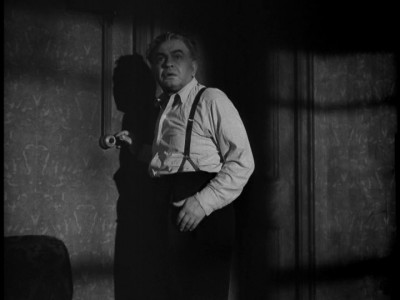
Roiling underneath the surface suspense, which keeps us captivated at the level of that twisty, twisted plot and the characters who are in over their heads, is all the subtext that Lang and screenwriter Dudley Nichols have packed into their story, which has enough clashing binary elements to make sparks fly at every turn: the timid, inhibited sexual and social mores of the middle class contrasted with the relative sexual freedoms of the lower and upper classes; art vs. commerce; and the obligatorily hidden emotions and creative/aesthetic impulses of an ordinary man opposed to the differing kinds of crassness that are predominant in either the commercial-capitalist world he's from or the shadier milieu his creative and sexual restlessness have led him into. The big one, though, is innocence/naiveté and its futile, doomed head-on collision with a sinister world and a human nature that are hellbent on disillusioning anyone's romanticized notions of anything. These oppositions are all wonderfully conveyed by Lang through his style, which has never been more an evocatively synthetic, nighttime/nightmarish urban landscape than it is here, with rain-soaked sidewalks and brilliantly variegated shadows and light giving the impression, as in many of the best noirs, of an abstract idea of The City (and Lang is nothing if not a top-notch urban filmmaker), its crimes, and the heart of darkness that throbs at the very deepest part of its core. The bright, white, light-filled penthouse Chris is wooed and manipulated into renting for Kitty is a completely false paradise; as photographed by Lang and his miracle-working artist of a DP, Milton Krasner (The Bank Dick, All About Eve), it's too white, too beautiful, like a heaven nobody with an ounce of sense would believe in, though that visual strategy also makes the temptation do so readily apparent and understandable. In this way, Lang's dramatically pessimistic view of the world is there in the shadow and light, in the interiors and exteriors that are shot to look dubious, unpredictable, and potentially entrapping even at their most apparently comfortable and familiar. The domestic space of Chris and Adele's apartment, for example, holds no safety or comfort for the man, which is highlighted by both the way Lang and Krasner compose, block, and film the shots and by the huge, imposing, ugly portrait of the late Mr. Adele hanging over the mantle and always looking down on them--a mockery of both Chris's position in the household and his ambitions as a real painter who would never countenance such an eyesore.
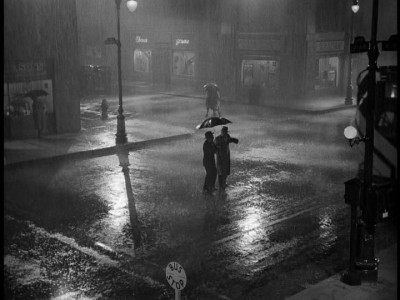
Scarlet Street stands as a prime, eternally rich and enjoyable example of how a story that might be pure pulp in the form of a novel or article can become a beautiful, multidimensional work of art when it undergoes the alchemy of the cinema, with its ever-porous narrative/storytelling dimension always leaving plenty of room for any creator so inclined to find the profundity, tragedy, and poetry of the situations, events, and characters through style--the particular ways in which all of those things are shown to us and played out. Lang and co. are just such creators; Lang's way of using space and light to create atmosphere is virtually peerless, and it makes all the difference in how we experience what the characters are experiencing. Scarlet Street thus takes a lurid story that would have been easy enough to reduce to pure titillation and exploitation and makes it a powerful expression of the way the world as it is exists can seem so adamantly and actively opposed to the world we hope and long for--of the sad dangers of hope and optimism unleavened by the strong dose of cynicism that's bound to be administered by life anyway, ready or not. At the beginning, the oddly benign, trusting, homely visage of Edward G. Robinson is something at which we might willingly join the cruel, worldly-wise Kitty in laughing at. But by the end, after it's been progressively blinded by the too-bright opulence of that luxury apartment or worn down by the dark, wet city Lang has Chris journey through (or is that descend into?) until he's completely disoriented, the realization and resignation reflected there are too deep and irrevocable to be mocked; no-one could be faulted for weeping instead.
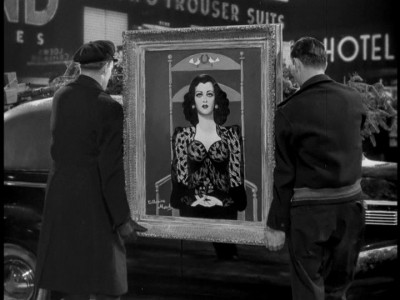
THE BLU-RAY DISC:
We've all seen the terrible-looking editions of Scarlet Street that have floated around on DVD thanks to the film's public-domain copyright status, but Kino picked up that ball and ran with it for their beautiful 2005 DVD restoration, and this Blu-ray disc's AVC/MPEG-4 encoded, 1080/24p-mastered transfer (at the original theatrical aspect ratio of 1.33:1) looks even better--sharper, with a more subtle and clear conveyance of the picture's darks and lights--than that did. There is no aliasing or edge enhancement at all, and the very occasional, very moderate vertical lines and some other signs of minor print wear are a small price to pay for the real celluloid texture that Kino has conscientiously avoided noise-reducing away, and the transfer is overall a superb presentation.
Sound:The disc's restored PCM 2.0 mono soundtrack is also near-perfect, both giving us the fullest, clearest, most resonant sound possible while also revealing some of the sound-recording limitations of the time and some possible, very rare slight crackle or distortion accrued through print wear. There is nothing here that's imbalanced or so distorted that it's a distraction, though; again, a marvelous job.
Extras:--A full-length audio commentary by Lang expert and author David Kalat, in which he proves himself perfectly competent at offering an exegesis of the film's story and style but especially adroit at giving us all the context for its making. Kalat offers offering a very good summation of the studio-system context in which the film was made; comparisons and contrasts to Jean Renoir's film 1931 La Chienne, upon which Lang and screenwriter Dudley Nichols based Scarlet Street; inside details of Lang's, Bennett's, and producer Walter Wanger's production company, Diana Pictures, which gave the collaborators a degree of independence to which much of the credit for the film's superbness is due; as well as many a stray but fascinating detail, such as that children's book author Ludwig Bemelmans, of Madeline fame, was at one point to have been the film's screenwriter.
--A stills gallery featuring photos from the shoot and many nice images from the film's international marketing, as well as a brief selection of trailers for other Kino Classics releases.
FINAL THOUGHTS:A juicy and suspenseful film noir--one of the very greatest--that could easily double as a profound and unexpectedly moving (if meticulously avoidant of sentimentality) existential tract, Fritz Lang's Scarlet Street is indispensable viewing. Surely, one cannot call oneself a true aficionado of either classical studio-system cinema or film noir without having basked in its dark, rainy, desperate, and nightmarish urban glow. Our protagonist's wandering away from his stifling, wholly unsatisfactory domesticity into a maelstrom of unleashed vice and treachery is supposedly set in Greenwich Village and Brooklyn, but as Lang and director of photography Milton Krasner film their backlot-constructed New York, the environment and atmosphere of the setting make it an uncannily potent, vaguely recognizable but unsettlingly unfamiliar place, like something out of a nightmare--a universal cinematic stand-in for the exciting but menacing City at Night and how easy it is to get waylaid, lost, and trapped there. It is very likely Fritz Lang's greatest American film (and when you consider the also-unmissable The Woman in the Window and The Big Heat, that's really saying something), one of the finest-wrought exemplar of all that was right with golden-age Hollywood cinema. It works at every moment as both a preeminently well-told, immediately engaging, accessible story and as a work of highly sophisticated visual art whose subtleties and nuances transform its story (which could on paper seem like mere tawdry desire, crime, and cheap thrills) into a masterfully choreographed ballet of shadow and light, the ultimate cinematic representation of a dark night of the soul. Highly Recommended.
|
| Popular Reviews |
| Sponsored Links |
|
|
| Sponsored Links |
|
|
| Release List | Reviews | Shop | Newsletter | Forum | DVD Giveaways | Blu-Ray | Advertise |
|
Copyright 2024 DVDTalk.com All Rights Reserved. Legal Info, Privacy Policy, Terms of Use,
Manage Preferences,
Your Privacy Choices | |||||||









